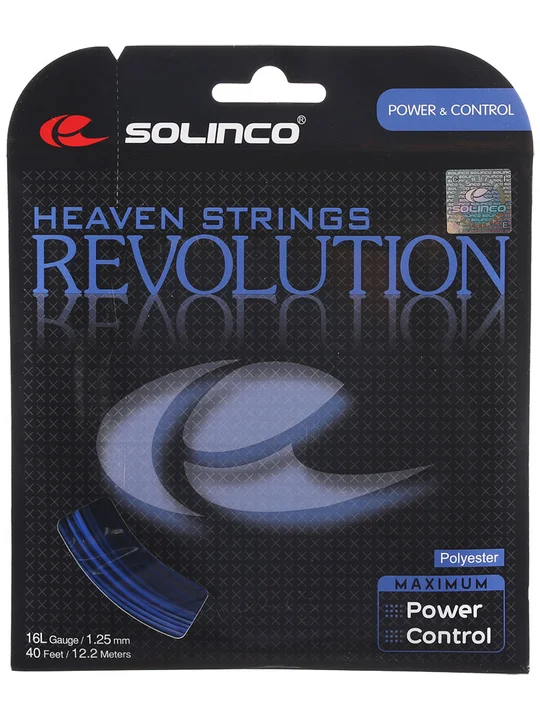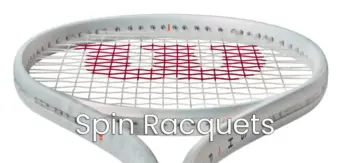Solinco is well-known and respected for their polyester offerings. Our contributor Oak Gast has written a Solinco Revolution Review.
Solinco Revolution Review
In addition to being utilized by recreational and college players en masse, they have several tour endorsements for their iconic lines like Confidential, Tour Bite, and the ever-classic Hyper-G.
Revolution (check out the string at Tennis Warehouse) was initially hailed to me mainly as a slightly softer alternative to their stiffer polyester flagships via word of mouth. On paper, this makes sense. Our own Tennis Warehouse University team found the 1.25 gauge to test at 213 lbs per inch for stiffness (Hyper-G comes in at 218 comparatively) and to be relatively average as far as tension maintenance to loss goes for most strings (about 30% over extended hitting sessions before breakage).
There is something in the name…
So what is Solinco going for here with their intent? Their statement of design asserts “maximum power and unbeatable control” which seems vague enough to appeal to most polyester users. Where Revolution jumps out spec-wise is the spin potential, all the way up at 8.0. Of the 20 strings ranked above it in spin potential, only two other strings have a lower tension loss percentage overall: Weiss Cannon Blue Rock N Power and both the 1.30/1.25 versions of Tecnifibre’s 4S. Both of these strings achieve slightly lower tension loss and have much higher stiffness ratings.
This means that on paper, out of the top twenty to thirty strings rated by Tennis Warehouse University for spin potential, Revolution is in a relative class of its own. It is one of the only strings with middling to good tension maintenance (<30% loss), ever so slightly soft feel (200-215 lbs per inch for stiffness), and still spin-friendly enough to be considered above average (8 on a 1-12 spin potential comparative scale). All the other strings with comparable spin and tension loss (4S, Solstice Power) have relatively high or low stiffness ratings, which may obscure the sweet spot range that Revolution settles in at.
On flatter balls, Revolution has mostly exceeded expectations.
How does it play?
The final result is a poly string that is extremely rewarding if appropriately utilized. I strung a full bed in a Solinco Whiteout 18×20 XTD frame at 54 lbs and another full bed at 49 lbs for testing. The string’s ample spin access and a slightly soft feel easily allow spin-based shots to be manufactured on a standard groundstroke topspin drive. On a full topspin-based loopy ball, the six-sided string has no difficulty gripping with enough force to shape your shot back down into the back of the court with high net clearance. The slice also benefits on both sides of the body, as the softer absorption mixed with the high spin potential allows for some extended dwell time that can be combined with highly satisfying cuts on the ball. Revolution performs superbly on spin-based shots and offers enough stability to feel solid upon quick and more lasting ball impacts.
On flatter balls, Revolution has mostly exceeded expectations. The pickup rate on redirecting pace for heavy groundstrokes or serve returns feels responsive and comfortable. As you start to drive balls with Revolution and get your full weight behind groundstrokes, the strings do not lose their stability or sense of place upon rapid or heavy acceleration through the ball. The string feels solid from a tactile perspective but not too harsh or muted overall.
Stroke by stroke
Serving with Revolution proved difficult initially, but its slightly heftier feeling became useful over time. As everyone’s serve technique varies so much in terms of racquet head speed and swing path, it’s tough for me to say how much of my own experience with the string reflects its actual ability in this area. However, I have not found anything glaringly wrong per se about the serving experience with Revolution. If anything, it has required me to focus up while hitting a serve instead of letting my mind wander.
Volleying with Revolution is pleasant and reliable. While perhaps not as crisp or quick as some other big-name polys (Hyper-G, ALU Power, RPM Blast) the spin access makes up for it by increasing the shapeable nature of each shot. Tension maintenance overall performs as about as expected. While nothing extraordinary as it drops like all polys do, but as noted earlier, it is relatively longer lasting than your other “spin-to-win” strings.
Summary
I have tried Revolution in a hybrid setup with natural gut, Ashaway monogut, and Head Velocity MLT. It has done well in all of these setups but has shined in the Ashaway monogut combo for me. The natural gut setup played superb as promised, but it broke relatively quickly, and the multifilament hybrid was solid, but I preferred the full bed of Revolution over it.
Revolution is not the string the name suggests. But it is revolutionary as far as how under the radar it goes for the level of performance it offers. Potentially, it seems it is the case where Solinco may have a similar problem to Head’s racquet lineup. There are so many good options, which means some gems might get overlooked…
















I’ll be trying revolution soon, thanks Oak!
Hi.
In your hybrid set ups with Revolution. Which were best?
And where did you put in the Revolution 1.25 (main/cross)?
Thanks!